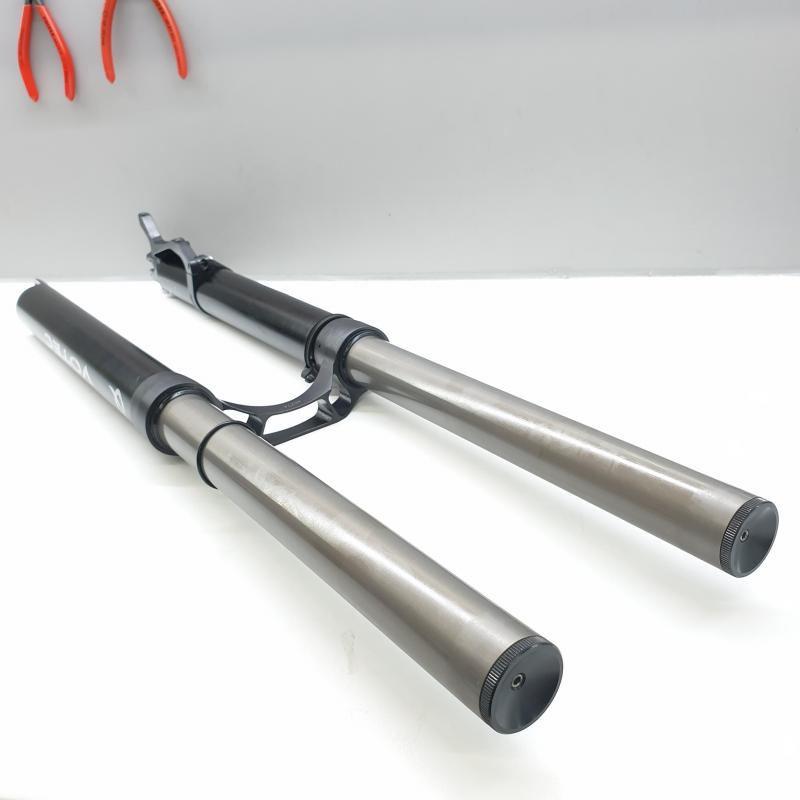Tuning
Adjustment of the suspension travel
The suspension travel of the Classic fork can be adjusted from 60 to 140mm in 20mm
steps. To change the suspension travel, only the spring packs have to be removed
and change the number of spring coil elastomers.
- Required tools:
5 mm Allen wrench (Allen).
- Before starting work, study the diagram so that you know exactly which parts are meant.
are meant.
- First loosen the hexagon socket screws on the upper triple clamp and on the stem clamps.
stem clamps. This is the only way to easily unscrew the spring assemblies later.
- To change the spring travel, the large screw cap must be removed.
be removed. To be able to do this, the guide rod must be held with a 5 mm Allen key and then the cap screw can be unscrewed by hand.
be unscrewed. Now all parts can be removed from the piston rod.
- Now set the desired spring travel by the appropriate number of lastomers
(Ø16mm), separated by one washer each.
Spring travel 140mm 120mm 100mm 80mm 60mm
Number 1 2 3 4 5
- Now screw the knurled cap (thread facing down) back on.
- Then adjust the spring and the spring stiffness elastomers (active elastomers) in
in reverse order to the removal procedure.
- Do NOT use the spring travel elastomers (Ø16mm) as active elastomers.
- Counter the cap screw again with the 5 mm Allen key.
- Screw on the pressure tube.
- The whole spring assembly can now be screwed back into the standpipe and the Allen screw screwed into the dropout (tightening torque 4Nm).
Adjusting the spring rate
To change the spring rate (hardness), VOTEC offers three different types of
elastomers.
thin Ø20mm = soft
medium Ø25mm = medium
thick Ø28mm = hard
- Additionally different steel springs can be used
soft - medium - hard - very hard
- Unlike air fork (Air² or Air Plus) VOTEC can not give an exact setting table, because it is always on the area of use, driving style, body weight and personal feeling, as one the fork tuning
would like.
- To change the spring rate, proceed in the same way as when changing the spring travel.
spring travel, except that you do not change the number of spring travel elastomers
and only change the active elastomers.
All elastomers should be greased regularly (every 50 hours of operation).
use VOTEC grease, which is also used for maintenance of plain bearings.
bearings.
Adjustment tip: The easiest way to adjust the Classic fork is via the negative spring travel. To do this, there is an O-ring on a standpipe that is pushed all the way down. Now put on the bike and load the fork normally. Now should
the fork should dip 20 percent of the adjusted spring travel. If it is less, then
the fork is too hard, if it is more, then the fork is set too soft.
Overall, the fork should be adjusted so that it almost
sag.
Care and maintenance
- The plain bearings in which the stanchions are guided should be cleaned and regreased every 50 operating hours and at least once a year, depending on the operating conditions.
and regreased. For this purpose you should use the VOTEC fork grease.
- The plain bearings are wearing parts. To protect the stand pipe surface, they are
softer than the stand pipe surface.
Procedure:
- Required tools:
4 mm Allen wrench (Allen key).
Torque wrench with 4 mm Allen key
Bearing welding rod or similar
VOTEC grease
- Unscrew the screw on both dropouts using a 4 mm Allen key.
unscrew. When doing so, the adjusted pressure can remain in the system.
- Loosen the brake from the lower part of the fork. With Bowden cable brakes, it is sufficient to unhook the
unhook the Bowden cable from the brake lever. For write brakes, unscrew the brake caliper from the disc brake adapter. Under certain circumstances the
brake line may be additionally secured to the standpipe. Remove this securing device as well. To secure the brake, insert something between the pads (thick cardboard).
(thick cardboard). If you come against the brake lever, you do not have to push the pads apart again afterwards.
- Possibly dismantle the sensor of the speedometer (models with cable).
- Remove the lower part of the fork from the stanchions.
- Peel out the scraper ring by hand.
- Pulling out the upper sliding bearing.
- Remove the three upper spacer bushings.
- Pull out the lower plain bearing.
- The lower two spacer tubes can remain in the lower fork section.
- Clean all disassembled components.
- When reassembling, follow the upper points backwards. Grease the plain bearings with VOTEC fork grease before installation.
- The arrangement of the spacer bushings is important. The plain bearing should always
be located between the wide collars. The first bushing should also be arranged
that the thick collar points downwards.
- The bolts at the dropouts should be tightened with a torque of 4 Nm
should be tightened.



